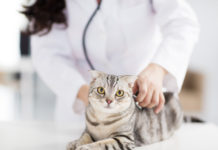My cat, Puppi, has personality plus. Even my friends who dont care for cats have become endeared to her and always ask about her. Shes fed a good diet, her coat is soft, her eyes are clear, and shes a beautiful two-year-old calico. However, she doesnt purr. I can feel a vibration in her neck, but no sound! Her meow seems normal, but I miss the purr. Whats wrong?
Hmmm, so you have friends who dont like cats? In truth, I do too. For reasons that completely escape me, cats are as polarizing as some politicians: people either love them or they hate them. There seems to be a lot more room in the middle as far as dogs go, because very few people claim to intensely dislike canines. Even folks who are not self-confessed dog lovers usually at least tolerate mans best friend. But such is not the case with kitties, as we ailurophiles know too well.
When someone tells me she hates cats (maybe just to get my goat?), I always ask, And what cat might that be? Even though all cats share certain traits, each one is an individual with its own distinctive personality and repertoire of behaviors. Im convinced that many self-proclaimed cat haters are just one kitty away from becoming cat lovers. Often times Ive seen some homeless cat wander into the life of someone who claims to dislike cats, and then proceed to completely disarm and charm the person. Ive even known some recent converts to try to excuse their new behavior by saying something like, You know, Doc, this cat acts just like a dog. But you know, of course, the cat is simply acting like a cat.
Meows and murmurs
Back to Puppi. Cats are able to generate roughly sixteen different vocal sounds, and theyre generally classified into three categories: vowel sounds, high-intensity sounds, and murmurs. Vowel sounds (meows) are created when a cat opens its mouth and then gradually closes it while vocalizing. There are lots of kinds of vowel sounds: demands, complaints, wails, mating cries and begs are examples. High-intensity sounds are made open-mouthed, and are emitted during emotionally intense experiences. They include snarls and hisses. Murmurs are sounds cats make with their mouths closed, and the purr is probably the best recognized and most loved. (Ive included some facts about purring at the end of the column.)
The precise manner by which cats create this unique sound remains a bit of a mystery. Some believe it involves vibration of major blood vessels within the chest, or vibrations of small bones that connect the larynx (voicebox) to the base of the skull, or vibrations from the diaphragm, the thin muscle separating the chest from the abdomen. However, supported by some rather sophisticated acoustic measurements, many researchers believe that the purring sound is created, at least in part, by the repeated rapid opening and closing of the vocal folds, specific structures within the larynx. This is my favorite theory, and you can test it yourself. Breathe through your mouth, and as the air flows in and out, rapidly and repeatedly say “T.” You won’t be able to do this fast enough to create a purring sound (roughly 25 vibrations per second), but you can get a sense as to how the character of the sound changes as you inhale and exhale, as it does when cats purr.
With purrs, there is much variation from cat to cat. Some cats have really loud purrs and will seemingly purr at the drop of a hat (however, the loudness of the purr and the frequency of purring dont seem to be related). One of my former clients cats, Motor, was one of these types of fellows. You could here him purr from across the room. But other cats have much quieter purrs, or they may not purr at all. Cats in this category, like Puppi, shouldnt be considered unhappy or dysfunctional in any way; this is just the way they are.
Purr facts
Purring is not only a sound cats make when contented. Sometimes cats purr when they are sick or even terminally ill.
Pumas, cheetahs, ocelots and some other wild cats purr.
Cats dont purr during the deepest phase of sleep.
Purring takes place during both inhalation and exhalation, although the purr sound is slightly different during the two phases.
Cats are able to purr and meow at the same time.
Cats first begin to purr at about two days of age. Both mother and kittens usually purr during nursing.



